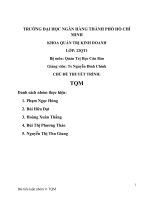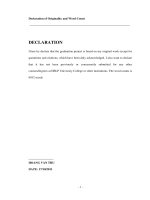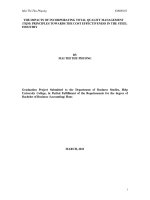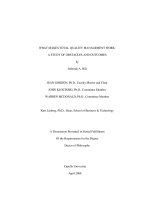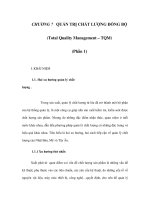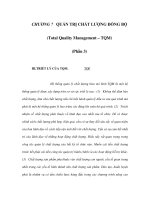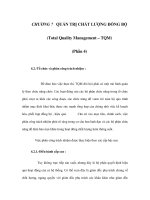key success factors of total quality management (tqm) – an empirical study in vietnamese paint and coating industry
Bạn đang xem bản rút gọn của tài liệu. Xem và tải ngay bản đầy đủ của tài liệu tại đây (1.98 MB, 82 trang )
iii
Abstract
This study is an empirical examines key success factors of total quality
management (TQM) to the result of quality implementation in paint & coating
industry in Vietnam. TQM system helps the enterprise to identify the
relationships between TQM factors and the enterprise performances
(Sebastianelli, 2003).
The quantitative data were obtained through a survey from 260 quality managers,
top management managers, factory managers and purchasing managers of Paint
& coating manufacturing industry in Vietnam. The objectives of the research are
to provide the key success factors (KSF) and measure their relationship to the
quality implementation as Top management responsibility, Process design,
Employee training, Employee involvement, Benchmarking, and customer focus.
Then, the key findings will be provided and recommendations to enhance the
level of TQM in paint and coating enterprises.
iv
Table of Contents
Acknowledgement i
Commitment ii
Abstract iii
List of table vii
List of figure vii
Chapter 1: Introduction 1
1.1.Introduction 1
1.2.Backgrounds to the research 1
1.3. Research issues, objectives and questions 4
1.3.1. Research issues 4
1.3.2. Research objectives 6
1.3.3. Research questions 6
1.4.Research methodology and scope 6
1.5. Thesis structure 7
1.6. Conclusion 8
Chapter 2: Literature Reviews 9
2.1. Introduction 9
2.2. Total quality management 9
2.2.1. Definitions total quality management 9
2.2.2. Key success factors of TQM 10
2.3. Development of research model and hypothesis 14
2.3.1 Top management responsibility 14
2.3.2. Process design 14
2.3.3. Employee training 15
2.3.4. Employee involvement 16
2.3.5. Benchmarking 17
2.3.6. Customer focus 18
2.3.7. Result of implementing quality management 18
v
2.4. Proposed research hypotheses and research model 20
2.4.1. Research Hypotheses 20
2.4.2. Research Model 20
2.5. Conclusions 21
Chapter 3: Research Methodology 23
3.1. Introduction 23
3.2. Research design 23
3.3. Questionnaire development 24
3.3.1. Operationalization of measurement scales 24
3.3.2. Preparation of draft questionnaire 26
3.3.3. Questionnaire design 27
3.4. Pilot study 28
3.5. Main survey 28
3.5.1. Population and sampling 28
3.5.2. Questionnaires administration 30
3.5. Data analysis techniques 30
3.5.1. Data cleaning 30
3.5.2. 31
3.5.3. Exploratory factor analysis (EFA) 31
3.5.4. Correlation analysis 33
3.5.5. Multiple linear regression (MLR) analyses 33
3.6. Conclusion 34
Chapter 4: Data analysis and result 35
4.1. Introduction 35
4.2. Data cleaning, Data filer and Sample description 35
4.1.1. Data cleaning and data filter 35
4.2.2. Sample description 36
4.3. Reliability test of measurement 38
4.4. Exploratory factor analysis (EFA) 41
vi
4.5. Testing the research model and the hypothesis 45
4.5.1. Testing the correlations of the constructs 45
4.5.2. Testing assumptions of Linear Regression 46
4.6. Multiple Linear Regression Analysis 47
4.7. Conclusion 51
Chapter 5: Conclusions and implications 52
5.1. Introduction 52
5.2. Discussion of findings 52
5.3. Implications 54
5.3.1. Theoretical implications 54
5.3.2. Practical implications 55
5.4. Limitation of the research 56
5.5. Conclusion 57
Bibliography 58
Appendix 1: Survey of Questionnaires English version 61
Appendix 2: B ng kh n ti ng Vi t 64
Appendix 3: Descriptive statistics of variables 67
Appendix 4: Measurement scales reliability of variables 67
Appendix 5: Exploratory Factor Analysis (EFA) 71
Appendix 6: Correlations 74
Appendix 7: Graphic analysis of regression assumptions 75
Appendix 8: Regression 77
Appendix 9: Responders interview list 78
vii
List of table
Table 1: Key success factors of TQM 10
Table 2: Key success factors of TQM in some previous studies 12
Table 3: Research hypotheses 20
Table 4: Measurement scale of variables 25
Table 5: Descriptive statistics on all factors 36
38
Table 7: Cronchbach's alpha values 39
Table 8: KMO and Barlett's Test 41
Table 9: Total variance explained 43
Table 10: Rotated Component Matrix 44
Table 11: Pearson Correlations 46
Table 12: Regression when RIQ (Y) is dependent variable 48
Table 13: Results of testing hypothesis 50
List of figure
Figure 1: The market share in Vietnamese paint and coating industry 4
Figure 2: Research Model 21
Figure 3: Research process 23
Figure 4: The updated research model 51
Figure 5: The process of benchmarking 55
1
Chapter 1: Introduction
1.1. Introduction
This chapter explains the reason of choosing the title, and briefly explains the
problem and objectives of the research. The scope and data collection methods of
the research are also presented in this part. It is necessary to overview about the
Vietnamese paint and coating industry in order to illustrate to the readers about the
weaknesses in the quality management of local companies in comparison with
foreign companies that have the competitive advantages in higher service quality
and technology. The author also addresses the fact that there were not so many
previous researches were written about the total quality management (TQM) and
finding key factor success to result of implementing quality management in paint
and coating industry in term of Vietnamese market characteristics.
1.2. Backgrounds to the research
Scott Detiveaux and Allen Tsaur (2011) reported that the global paint and coating
industry has been affected by the global economic downturn since 2008. They
provided the growth rate before and after the global economic downturn which are
30% and 3% respectively, showing the negative impacts of the global economy to
the paint and coating industry. However, Scott Detiveaux and Allen Tsaur (2011)
also said that Asia Pacific was only one bright spot in the gray picture of global
paint and coating industry. From 2004 to 2009, the growth rate of this industry in
Asia Pacific was amazing, 60%, outperforming the global economic downturn.
From 2010 to 2011, the growth rate of paint and coating industry has not remained
at high speed and reduced to 30% but still higher than the growth rates of any other
areas in the world market. During the economic downturn, the production volume
of this area took 41% of the 27 billion liter of the global coating volume (Scott
Detiveaux and Allen Tsaur, 2011).
2
In the Asia Pacific market of paint and coating industry, China is the strongest
market in term of production and consummation. During the period of 2009 to 2011,
the annual growth rate of China was more than 16%. India was the second place
with the annual growth rate stood at 9%. Japan and Australia were two markets in
the Asia Pacific has been affected by the economic downturn with the annual
growth rate during the period of 2009 to 2011 were 0.7% and 1.5% respectively
(International Paint and Printing Ink Council, 2010).
With the high growth rate of Asia Pacific, the global structure of paint and coating
industry has been changed with the more focus on the Asia Pacific due to the slow
growth of Western countries and the high public debt in the Euro zone. Scott
Detiveaux and Allen Tsaur (2011) said that more and more formulators and suppliers
are coming to Asia Pacific for future growth. For example, the construction spending
in China and India have increased by 10% from 2009 to 2011 while the same figure
in US has decreased by 4%.
In Vietnam, the author has recognized that the paint and coating industry is targeted
as the top potential market in Asia Pacific with the annual growth rate was 21% in
the period of 2003 to 2009 (). Tran Van Chau (2012)
estimated that Vietnamese paint and coating industry will be valued at US$2.5
billion in 2022 in despite of the fact that the 2009 value of this industry was only
US$ 620 million.
The reason is that Vietnam is on the way of modernization with a lot of new
construction, hydropower plants and road are being built, leading to the increase of
demand for paint and coating products. In term of sustainable development,
Vietnam Government has established the chemical regulation for the companies
operating in paint and coating since 2008. This law suit requires the paint and
coating companies have to comply with the safety and quality in manufacturing
products.
3
With the more focus and supports from the Government, Vietnamese paint and
coating industry has been increasing during the time. The highest achievement of
Vietnam paint and coating development is to join the Asian Paint Industry Council
(APIC) in 2008.
Up to now, there are around 400 companies operating in paint and coating industry
in Vietnam, according to Vietnam Paint and Printing Ink Association (VPPIA). The
market is constructed by two main products that support for two distinct purposes,
decoration and industrial usage. In term of product volume, the decorative paint and
coating product consumes the largest market share with more than 70% in the total
production volume of Vietnamese paint and coating industry.
The Vietnamese paint and coating is also classified into four market levels. The
high-end market includes the products from famous international companies coming
from US, Japan or England such as Azko Nobel, Nippon, Jotun with the total
market share is about 35%. These companies have the advantage of better
distribution network compared to other companies. The second one is the medium
market with the participation of several companies coming from Asia such as 4
Oranges, TOA, Sea Master, etc. They are selling their products for around 25% of
the market share. The medium-low market includes the Vietnamese companies such
as Joton, Kova, Tison, Nero etc. consuming for 15% of the market share. The last
one is the non-brand name products which are distributed unsystematically in
Vietnam with the market share is around 25% ().
4
Figure 1: The market share in Vietnamese paint and coating industry
(Source: )
1.3. Research issues, objectives and questions
1.3.1. Research issues
ompanies operating in paint
and coating industry is now controlled by the foreign companies which is
accounting from more than 50% of the total market share, raising the concern for
the high competition between domestic and foreign companies. In fact, according to
VPPIA (2009), the total number of companies exited to the paint and coating market
was 70 companies, accounted for around 20% of the total operating companies.
Hence, the author believes the concern for high competition between companies in
the Vietnamese paint and coating industry is true.
The author also addresses that the WTO accession has been affecting more on the
competition in the Vietnamese paint and coating industry in the years to come as
Vietnamese Government has to open the domestic market for the foreign companies
5
For locals companies the openness of domestic market is a real challenge, as they
now have to face older, more developed, international companies. The government
is still reluctant and preserves an environment that helps domestic companies.
However, the Vietnamese Government cannot support the domestic companies
forever as the rising of the foreign enterprises that have better manufacturing
technology and product and service quality.
The foreign paint and coating enterprises also have higher Research & Development
(R&D) capacity in studying new products and higher technology in manufacturing
that help the foreign companies to achieve the higher efficiency and cost saving.
The foreign companies also have higher quality of materials for manufacturing paint
and coating products as they have stronger supply network. Currently, the foreign
companies, with the higher technology production chain and better distribution
network, have been providing their diversified products to different types of
customers with the reasonable prices compared to the domestic companies. More
and more foreign products have the same price as the domestic products
().
focus on quality management in order to compete with foreign rivals in the future.
The paint & coating companies should built up their own quality management
which is based on the philosophy of Total Quality Management (TQM) originated
from Japanese, According to Karuppusami and Gandinathan (2006), TQM can be
the best way that helps the enterprises continuously improving quality and process
to achieve business performance.
However, there are not so many researches written about the role of total quality
management and in the Vietnamese paint and coating industry. With the strong
estimated growth rate of this industry, the quality management is one of the critical
6
success factors, leading to the higher competitive capacity of local paint and coating
companies in Vietnam.
1.3.2. Research objectives
To examine key success factors of TQM in the result of implementing total quality
management in paint and coating industry.
1.3.3. Research questions
are set to answer in the Chapter 3
What are key success factors of TQM impact the result of implementing total
quality management in Vietnamese paint and coating industry?
How do these key success factors of TQM impact the result of implementing
total quality management in Vietnamese paint and coating industry?
1.4. Research methodology and scope
In this study, the author uses 06 key success factors of total management quality to
result of implementing total quality management in Vietnamese paint & coating and
then, through the survey of questionnaires that are being sent to 260 samples to
coating & paint manufacturer in Vietnam.
The research was also done by using both of qualitative and quantitative methods.
According to Malhotra and Birks (2000) a qualitative research method is fit when
activities and behavioral of human will be investigated. The author used the
qualitative method by carrying out group discussions and deep interviews made with
5 customers working in the paint & coating enterprises that have experience and
reputation in paint & coating industry.
7
A quantitative method is an importance approach and it evaluates phenomena. This
purpose of this approach is collecting and analyzing data and then applying the data
to statistical testing. Quantitative study would be approach on the customer data
base in CBC Company (CBC is the chemical raw material distribution for paint &
coating manufacturers) by questionnaire and the data was collected for analysis.
factor analysis (EFA). Correlation analysis and multiple linear regression analysis
(MLR) would be used to test the research model and hypotheses. SPSS 20.0
software was used for data analysis.
1.5. Thesis structure
The thesis is structured into five chapters as:
Chapter 1: This chapter is highlighted the background to the research as well as
research issue, objective and research question.
Chapter 2: It is presented some review of literature to relate with issue of the
research and previous studies. Based on that, author provides research hypotheses
and then propose research model which will be used for Vietnamese paint & coating
industry.
Chapter 3: Three is to illustrate the research methodology as well as procedures that
will be used in the study. This chapter starts with a research design, pilot study, a
detail explanation was provided on questionnaire development, population and
sampling and data analysis techniques.
Chapter 4: It
descriptive statistics, using reliability test, EFA and multiple regression analysis
Chapter 5: It provides conclusion and recommendation as well as limitation of the
research.
8
1.6. Conclusion
Base on the overviews of current status of the Vietnamese paint and coating
industry, this research explains firstly the reason of choosing the title, and briefly
explains the problem and objectives of the research. The scope and data collection
methods of the research are also presented in this part. Then, this research will
present the relevant concepts used as foundation for analysis, suggestions and
solutions in this research. It includes literature review on various management fields
such as Total Quality Management and model to measure base on the key success
factors to the result of implementing total quality management.
The purpose is to measure, analyze the problems, and to come up with lessons
learnt and solutions for implementing total quality management in term of paint and
coating industry. Finally, the research will provide recommendation as the most
suitable solutions and conclusion conducted from the survey.
9
Chapter 2: Literature Reviews
2.1. Introduction
In this chapter, the author examines the relevant studies about the total quality
management dimensions and result of implementing. The quality management can
be found in the theory of Total Quality Management which was invented by the
Union of Japanese Scientists and Engineers in 1949 and now become one of the
most effective improvement programmers. This chapter also reviews the key
success factors that affecting to the result of implementing total quality management.
In this study, the author adopts the key success factors proposed by Rao et al (1999)
Awan (2008) and Hoang et al (2010) including: Top management responsibility,
process design, Employee training, Employee involvement, Benchmarking and
customer focus.
2.2. Total quality management
2.2.1. Definitions total quality management
Total Quality Management (TQM) was firstly introduced in Japan by Union of
Japanese Scientists and Engineers in 1949. This is the committees of scholar,
engineers and government bodies with the objective is to improve the product
quality and life standard after World War II in Japan. The TQM philosophy then
expanded to American and became one of recognized improvement program in the
world (Kaynak, 2003).
an organization centered on quality, based on the participation of all its members
and aiming at long-term success through customer satisfaction and benefits to all
definition of TQM (Reed, 1996).
In term of the structure of TQM, (Khan, 2001) states that the TQM considers the
customer as the core factors while other factors (i.e. employee empowerment,
10
involvement and development, continuous improvement and use of systematic
approach to management) are the three most important components that support for
the customers focus strategy of the company.
2.2.2. Key success factors of TQM
In this section, the author examines some key success factor (KSF) of the TQM
through the previous studies such as (Tari, 2005) and (Claver, 2003) identifies three
KSF for the TQM as management leadership, formal evaluation model and
empirical research. Dale (1999) identifies management leadership, training,
continuous improvement as consistent findings in the work of quality leaders such
as Crosby, Deming, Juran, Ishikawa and Feigenbaum. The Malcolm Baldrige
National Quality Award (MBNQA), European Quality Award (EQA) and Deming
application prize are common formal TQM evaluation models used in the United
States of America, Europe and Japan respectively.
Table 1: Key success factors of TQM
Malcolm Baldrige
National Quality Award
(MBNQA)
European Quality
Award (EQA)
Deming application prize
(DAP)
1. Leadership
2. Strategic planning
3. Human resource
4. Process management
5. Information system
and data analysis
6. Customer and market
7. Business outcome
1. Leadership
2. Employee
management
3. Policy and strategy
4. Alliances and
resources
5. Process management
6. People results
1. Policies
2. Organization
3. Information
4. Standardization
5. Development and
usage of human
resource
6. Activities ensuring
11
7. Customer results
8. Society results
9. Key results
quality
7. Activities for
maintenance and
control
8. Activities for
improvement, results
and future plans
(Source: Tari, 2005)
Flyyn et al. (1994) provided seven quality practices of TQM (i) top management
support, (ii) product design, (iii) process management, (iv) quality information, (v)
supplier involvement, (vi) workforce management and (vii) customer involvement.
TQM is closely resembled to the preceding instrument developed by Saraph et al.
(1989). Powell (1995) comprehended the dimensions of quality management and
identified 12 factors from a thorough review of literature (Deming, 1986; Juran,
1986; Crosby, 1979; Flynn et al; 1995 and Saraph et al., 1989). These factors are (i)
Committed leadership or executive commitment, (ii) Employees empowerment, (iii)
Adoption and communication of TQM or adopting the philosophy, (iv) Closer
supplier relationships, (v) Training, (vi) Open organization, (vii) Closer customer
relationships, (viii) Benchmarking (ix) Process improvement, (x) Zero-defects
mentality, (xi) Measurements and (xii) Flexible manufacturing.
Hoang et al., (2010) provided six key success factors for TQM in manufacturing
and service companies in Vietnam as (i) customer focus, (ii) top management
commitment, (iii) information and analysis system, (iv) education and training (v)
employee empowerment, (vi) and process management.
Recently decade, many authors are finding key success factors of TQM as described
in the table 2.
12
Table 2: Key success factors of TQM in some previous studies
No Authors
Key success factors of TQM
1 2 3 4
5
6 7 8 9 10 11 12
1 Rahman (2001)
2 Brah et al. (2002)
3
Prajogo and
Sohal
(2003)
4 Talavera (2004)
5 Sila (2005)
6 Prajogo (2005)
7 Tari et al (2006)
8
Brah and Lim
(2006)
9
Karupusami &
Gandhinathan
(2006)
10 Demirbag (2006)
11 Sila (2007)
12 Ou et al. (2007)
13 Fryer et al. (2007)
14 Macinati (2008)
15
16
Al-khalifa et al.
(2008)
17 Salaheldin (2009)
18
Satish &
Srinivasan (2010)
19
Malik & Khan
(2011)
20
Arumugam &
Mojtahedzadeh
(2011)
21 Zehir et al (2012)
13
Note: (1) Leadership/Top Management (2) Customers Focus (3) Teamwork (4)
Process Management (5) Supplier Quality Management (6) Training (7) Strategic
Planning (8) People Management (9) Employee Involvement (10) Information and
Analysis (11) Incentive and Recognition (12) Continuous Improvement
Source: Masood ul Hassan et al. (2012)
In this context, the author will choose the research study of Rao et al (1999) is the
key paper. Rao (1999) provided 13 constructs which was the highest one compared
to Saraph et al.(1989), Flynn et al.(1994), Ahire et al. (1996) and Grandzol. Rao et
al (1999) research did not include so many factors compared to Karuppusami and
Gandhinathan (2006) and Sila and Ebrahimpour (2002).
Furthermore, the author believes that the research model of Rao et (1999) has better
than other research model of Saraph et al.(1989), Flynn et al.(1994), Ahire et al.
(1996) and Grandzol and Gerhson (1998) as their researches only focused on the
United State market while Rao et al (1999) focused on both of developing and
developed countries, including India, china, Mexico.
Hence, the author decided using model of Rao et al (1999) for this research.
However, the model of Rao et al (1999) should be refined before applying for the
survey of total quality management for Vietnamese paint and coating industry. This
refinement process was taken from the research of Awan (2008) and Hoang et al.,
(2010) which highlights the importance of six factors:
(1) Top management responsibility
(2) Process design
(3) Employee training
(4) Employee involvement
(5) Benchmarking.
(6) Customer focus
14
2.3. Development of research model and hypothesis
2.3.1 Top management responsibility
Top management affects positively and negatively to the quality management. Bersin
(2011) in the research on measuring the impact of top management responsibility and
the quality management of the company identified that top manager must set the
elements of corporate culture such as values, belief, measure, and taking appropriate
actions to improve the efficiency of corporate culture management, ensuring that the
corporate culture is managed and carried out by actions and learning rather than
words. Bersin (2011) also stated that the company should incorporate the service
quality dimensions to the key performance indicator of top management in order to
gain the commitment of top management responsibility on the quality management.
Puffer & Waldman (1996) said that, the role of top management to formalize the
company quality value and vision and project them in a clear, visible and consistent
manner. Rao (1999) has confirmed active and visible participation by top
management in quality management implementation is decisive in supporting the
action and behavior that steer the company to success in internal and external quality
performance.
H1: Top management responsibility affects to the results of implementing total
quality management in Vietnamese paint & coating industry.
2.3.2. Process design
Process design is defined as the behavior and systematic principles that are
important to managing the process rather than the result (Anderson et al., 1994; Teh
et al., 2008). It also points to the way how businesses strive to be success by
encouraging the need for knowledge innovation and creativity in process
improvement and optimization (Zairi, 1997).
15
Process design stresses the value adding to a process, increasing the productivity of
every employee and enhancing the quality of the company (Motwani, 2001). Ju et al.
(2006) showed that the basic requirements of process design are to lower down
costs, boost efficiency and reducing cycle-time.
According Lee et al. (2001) was that an effective process design will have an effect
on quality performance. Molina et al., (2007) concluded that the most significant
matter in the link between TQM processes control and the internal knowledge
transfer is the systematic use of control processes in a firm, which has an important
part to play on the search for and transfer of knowledge to which they are applied.
For firms that have put TQM into practice, it is widely known that TQM helps in
the continuous improvement of processes, and this will direct such firms to seek and
use the knowledge they need.
H2: Process design affects to the results of implementing total quality management
in Vietnamese paint & coating industry.
2.3.3. Employee training
Employee training is the process of continuous learning that helps the employees to
improve their working abilities (Robbins, 1992). In the world today, employee
training is important to every companies due to it helps to shape up and enhance the
knowledge, working skills and solving the daily problems (Nadler, 1984;Buckley &
Caple, 1990). Employee training is carried out by internal and external sources.
According to Chang (1999), the internal training is cost saving but it is not up-to-
date with the new trend in the market. In this context, the external training helps the
company updating the new trend in the market. Wang (2012), furthermore, states
ntials and
to adapt the current skills of the employees for future developments.
16
In term of the quality improvements, employees training are also adopted by many
organizations. Zeithaml & Binter (2003) identified that the effective employee
training will increase the product and service quality and therefore, increasing the
customer satisfaction. Wang (2012) and Chou (2010) state that companies should
lay their focuses on training system in order to educate the professional skills to
their employees. The professional skills training include the working mentality,
working attitude and working behaviors.
ss
(Wang, 2012)
H3: Employee training affects to the results of implementing total quality
management in Vietnamese paint & coating industry.
2.3.4. Employee involvement
Employee involvement is defined as the process of involving employees to the
working process of the company (Lawler, 1992). The theory of employee
involvement to the working process had started since 1930s and most of the
previous studies showed that the company can gain better results or higher business
performance when the employees are involved. Lawler (1992) stated that the
employees should be involved in the lowest level of the working process of the
company that is also called the bottom-up involving approach. However, the
bottom-up approach is only suitable with the case of which the individuals do
almost the working parts of the company. When the working parts are shared by
different individuals or teams, the bottom-up involvement will create the conflicts
between individuals and teams, thus decreasing the productivity (Lawler, 1990).
17
The research of Rees (1999) about team working and service quality identified that
the higher quality of service can be achieved through the higher employee
involvement in the quality management process. The team working gives the credit
to the employees of which they will have the stronger sense of teamwork. Rees
(1999) also highlighted the importance of the employee empowerment as the useful
tool for enhancing the employee involvement. In this context, the managers of the
company have to implement suitable mechanism to manage the employee
empowerment. For example, the managers can assign the extent duties to their
employees when the employees can do well the current task. The benefit of
assigning more duties helps the employees improving their working skills. The
research of Baptiste (2007) extended the studies of Pfeffer (2005), Gould-Williams
(2004) and Wilkinson (2005) of which the managers can increase the employee
involvement through the selection practices and internal promotion, employee voice,
and the sharing of employee involvement information respectively.
H4: Employee involvement affects to the results of implementing total quality
management in Vietnamese paint & coating industry.
2.3.5. Benchmarking
David Kearns (2002) defined the benchmarking as the way of measuring its product
and quality management with other competitors, especially to the market leaders.
Geson (1993) stated that the company should incorporate the quality management
and customer satisfaction as one of the benchmark for assessing business
performance of the company. Sisson et al (2008) highlighted that there are three
main types of benchmarking, including performance benchmarking, process
benchmarking and strategic benchmarking. The performance benchmarking means
the company compares its service and production quantity with other competitors.
Process benchmarking is the comparison between the internal processes of company
with other competitors. Strategic benchmarking is the way of which the company
18
compares its business strategies with other competitors and identifies the alternative
strategies for the future development.
H5: Benchmarking affects to the results of implementing total quality management
in Vietnamese paint & coating industry.
2.3.6. Customer focus
Customer focus is one of the main elements of TQM organizations must be
knowledgeable in customer requirements and responsive to customer demands, and
measure customer satisfaction through TQM implementation (Zakuan et al., 2010;
Raghunathan et al., 1997; Zhang, 2000). According to the review results from
Hoang et al (2010), customer focus is one of the most significations of key success
of TQM implementation in the industry in Vietnam.
Siddiqui and Rahman (2007) suggested that customer was a vital factor in achieving
control, improved quality of products and services, greater customer satisfaction,
enhanced productivity, slashed time consumption on production, optimization of
human resource use and flexibility
H6: Customer focus affects to the results of implementing total quality management
in Vietnamese paint & coating industry.
2.3.7. Result of implementing quality management
Many researches have study the impact of total quality management practices on
quality management manufacturing industries. Hoang et al (2010) has confirmed
TQM an effective to implementing quality management in service and manufacturer
companies in Vietnam. Ingram and Chung (1997) explained that total quality
management practices could increase customer satisfaction in health care industry.
Moreover, Haisin (2001) added that total quality management can improved the
19
competitive of the hospital in Thailand. Aghazadeh (2002) also agreed that a total
quality management practice is absolutely important for business.
Al-Saggarf (1997) revealed that total quality management practice can improved
customer satisfaction in electrical industry in Saudi Arabia. Moreover, Kanji et al.
(1999) reported that total quality management can increased customer satisfaction
in UK Universities.
Parzinger and Nath (2000) studied the relationship between TQM and software
quality and found that TQM implementation improves the software quality and
performance, and thus, increases customer satisfaction. Hasan and Kerr (2003)
examined the link between TQM practices and organization performance in service
organizations and discovered that TQM practices like top-management commitment;
employee involvement; training; supplier quality; quality costs; service design;
quality techniques, benchmarking; and customer satisfaction leads to higher
productivity and quality performance.
According Prajogo and Brown (2004), an empirical study within Australian
organizations to investigate the relationship between TQM practices and quality
performance, and the results indicated a strong and positive.
Brah and Tee (2002) showed the relationship between TQM constructs and
organization performance by measuring quality performance of Singapore
companies. They found that implementation of TQM leads to quality performance
and have positive correlation.
An empirical study conducted by Arumugam et al. (2008) explored the relationship
between TQM practices and quality performance on ISO9001:2000 certified
manufacturing organizations in Malaysia, they were finding revealed that TQM
practices were found to be partially correlated with quality performance.
20
2.4. Proposed research hypotheses and research model
2.4.1. Research Hypotheses
Base on the research analysis in above, the author proposed six hypotheses to test
the relationship between six independent variables to the results of implementing
total quality management in Vietnamese paint & coating industry.
Table 3: Research hypotheses
No Hypothesis statement
H1
Top management responsibility affects to the results of implement
ing
total quality management in Vietnamese paint & coating industry.
H2
Process design affects to the results of implementing total
quality
management in Vietnamese paint & coating industry.
H3
Employee training affects to the results of implementing total
quality
management in Vietnamese paint & coating industry.
H4
Employee involvement affects to the results of implementing total
quality
management in Vietnamese paint & coating industry.
H5
Benchmarking affects to the results of implementing total
quality
management in Vietnamese paint & coating industry.
H6
Customer focus affects to the results of implementing total
quality
management in Vietnamese paint & coating industry.
2.4.2. Research Model
The research model is based on the study of Rao et al (1999) and the refinement
from Awan (2008), Hoang et al., (2010) which highlights the importance of six
variables: Top management responsibility, process design, employee training,
employee involvement, benchmarking and customer focus.

